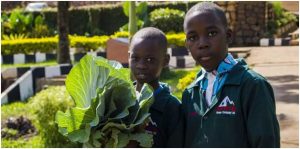Ugandan Students Turn Waste to Wealth
 30 Agustus 2019
30 Agustus 2019

Students holding vegetables from the school garden.
By Melissa Kyeyune
Aug 30 2019 (IPS)
Namugongo is a lush, forested community in central Uganda where tall trees are home to colourful birds and noisy monkeys.
The community has a tragic place in history: on 3 June 1886, 22 Ugandan Christian converts were publicly executed, on the orders of King Mwanga II of the Buganda Kingdom, in an attempt to ward off the influence of colonial powers with whom the Christians were associated.
The converts were elevated to sainthood by Pope Paul VI in 1964. Ugandans today see those converts as martyrs. They commemorate every 3 June, Martyrs Day, with weeklong celebrations that attract thousands of visitors from around the country.
During the week celebrants discard tons of waste, including plastic bottles, food and sewage, often throwing them into open channels, where they are likely to be transported by heavy rains into the premises of St. Kizito High School on the outskirts of the village.

Melissa Kyeyune
Waste to wealth
But the students of St. Kizito have come up with ways to collect that waste and transform it into wealth. They use the silt they collect to create and maintain the school’s pavers, and they create arts and crafts from the plastic straws and bottles, which they then sell.
The students also turn biowaste into organic fertilizer for the school gardens, where they learn to grow mushrooms, onions and cabbage, and they use dried briquettes made from biowaste as fuel to cook school meals.
A visit to the school reveals many recycling efforts by the students. Three large metal bed frames, refashioned by the students into a simple recycling facility, sit in the middle of the school courtyard. Here the students separate waste into paper, plastic and biodegradables.
“We get the dirty straws, wash them, and soften them. We then weave them into baskets, handbags, money purses, laptop bags, doormats and carpets. We sell the products to our parents and visitors,” says Patricia Nakibuule, one of the students producing the handcrafted items.
“I am responsible for ensuring that my fellow students, all 800 of them, have lunch to eat,” she says, smiling. “We use biowaste briquettes as fuel because this contributes to recycling and reduces deforestation.” The school does not need firewood and therefore does not have to cut down trees in the forest.
Aside from waste recycling, St. Kizito school equips students with skills in making soap and candles, caring for animals, landscaping and baking.

A student holding an SDG badge. Photo: Solomon Musisi
Students tell their stories
“At home, I rear poultry and grow tomatoes, so my parents do not spend a lot of money on food,” notes student Christine Nandujja, who says that she is applying smart farming concepts learned in school back at home.
Joseph Kakande, the school’s sports prefect, enjoys vegetable growing as much as basketball. “I learnt how to grow onions and mushrooms in school, then I started to do the same at home. It started off as a small project, but now I grow enough to even supply a hotel. I paid half of my last term’s school fees using the profits.”
To train current students, the school engages former graduates as well as other young experts in waste-to-energy projects. Brian Galabuzi, CEO of WEYE Clean Energy Company, a waste-to-energy project, trains young people in waste management and clean energy and uses the school as a laboratory for his award-winning initiatives.
He told Africa Renewal, “When I first came to the school a few years ago, I was a young university student with crazy ideas, but the students jumped right on board. They had come from rural areas and saw my ideas as an opportunity for them to develop their own skills. I benefitted greatly from their support.”
Today Galabuzi travels the world, showcasing ways to turn waste into clean energy.
Rhoda Nassanga, an engineer and a specialist in water conservation, regularly conducts training for the students. “My goal is to impart knowledge to the students while they are still in school and teach them about sustainable development goals,” says Nassanga. She benefits as well, as training the students allows her to use her engineering skills.

Brian (WEYE Clean Energy) displays a bag of briquettes. Photo: Solomon Musisi
Positive effects on the community
In turn, St. Kizito students have been training Namugongo community residents to make arts and crafts out of plastic waste and, as a result, earn incomes.
Now both the St. Kizito students and the larger Namugongo community are making efforts to preserve the environment, create ecofriendly businesses, manage environmental projects and use natural resources in sustainable ways.
Frederick Kakembo, the director of St. Kizito High School, who has a background in community development, says instructively, “I believe that you must first use what you have before you look elsewhere.”
*Published by the United Nations, Africa Renewal reports on and examines the many different aspects of the UN’s involvement in Africa, especially within the framework of the New Partnership for Africa’s Development (NEPAD). It works closely with the many UN agencies and offices dealing with African issues, including the UN Economic Commission for Africa and the Office of the Special Adviser on Africa.
The post Ugandan Students Turn Waste to Wealth appeared first on Inter Press Service.
Excerpt:
Africa Renewal*
The post Ugandan Students Turn Waste to Wealth appeared first on Inter Press Service.
